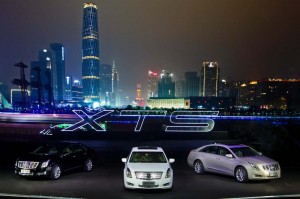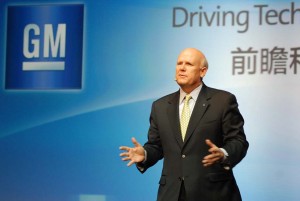General Motors Co. continues to go big in China.
GM and its Chinese partners broke ground this week on not one but two new assembly plants as well as a major expansion of the Pan Asia Technical Automotive Center.
The new assembly plants are located in Shanghai in eastern China and Chongqing in the center of China. The expanded technical center will also be located in Shanghai, one the major hubs of China’s auto industry. China has become the world’s largest automotive market in the past decade.
The investment in the two new plants totals $2.4 billion, which is only a fraction of the $11 billion GM plans to invest in China during the next three years.

The new Cadillac XTS gets a splashy launch during China's annual auto show. GM is building two plants there to build Cadillacs.
The new Shanghai plant will manufacture Cadillacs.
In 2012, GM sold more than 2.8 million vehicles in China, making it the company’s single largest market. The automaker and its Chinese partners are on track to sell more than 3 million vehicles this year even though the Chinese economy shows signs of slowing.
GM Chairman and CEO Dan Akerson, who attended the groundbreaking ceremony in Shanghai said: “General Motors made a long-term commitment to China when we established our Shanghai GM and PATAC joint ventures more than 15 years ago.
“Today, we are renewing that commitment while celebrating our outstanding partnerships with SAIC. We are also sending a strong message about the important role of Shanghai and China in GM’s global operations.”
“Shanghai GM’s new plant and PATAC’s new facility will enhance our ability to engineer and manufacture vehicles for our customers across China,” said Ye Yongming, president of Shanghai GM. “They will support the full implementation of our luxury car strategy while allowing us to address competitive challenges well into the future.”
The new plant at Shanghai GM’s Jinqiao operations in Shanghai has a planned annual capacity of 160,000 luxury vehicles. It will include a body shop, paint shop, general assembly shop, auxiliary facilities, and high-speed and brand experience center.
The state-of-the-art plant will adopt the world’s most advanced automation systems as well as a range of new technologies and processes for lean and green operations. Cadillac has set goals of tripling its annual sales in China to 100,000 units by 2015 and increasing its share of China’s luxury car market to 10% by 2020.
After rapid growth, sales of premium cars in China will probably increase about 4% this year, or about half the pace that the automaker had expected at the start of the year, Bob Socia, head of GM’s operations in China. GM has predicted total industry sales in China will increase about 7% to 8% this year.
Shanghai GM is in the midst of refreshing its brands, product portfolios and technologies in order to strengthen its position in the market during the long term.
PATAC’s new R&D facility will allow engineers and designers to respond more quickly to the changing demands of Chinese consumers, GM officials said.
It will include an advanced design and styling center, vehicle engineering facility, powertrain engineering facility and new energy facility. It will house a dedicated vehicle development and engineering team. The facility will complement PATAC’s Jinqiao Design and Engineering Center and Wanggang Testing and Pilot Production Center, both in Shanghai, and the Guangde Proving Ground.
The new Chongqing plant will help SGMW keep up with strong demand for its products, especially in China’s central and western regions. Last year, the joint venture sold more than 1.4 million vehicles in its home market, making it the leader among Chinese mini-commercial vehicle producers. In the first five months of 2013, SGMW’s sales in China exceeded 680,000 vehicles.
(Click Here to read about GM’s $11 billion plans for China.)
Chongqing is one of China’s largest cities and an industrial center in midwestern China. It has well-established infrastructure, a favorable investment environment and a developed automotive components industry.
SGMW’s original manufacturing base in Liuzhou, Guangxi, in southern China, has an annual production capacity of 800,000 vehicles. Its production base in Qingdao, Shandong, has an annual capacity of 500,000 vehicles.
(China will soon be the world’s largest luxury car market. Click Here to read more.)
The joint venture’s Liuzhou Baojun passenger car production facility, which opened last November, has an annual capacity of 400,000 vehicles. With the Chongqing base, SGMW will be able to produce more than 2 million vehicles per year by the end of 2015.
GM has 12 joint ventures, two wholly owned foreign enterprises and more than 55,000 employees in China. GM and its joint ventures offer the broadest lineup of vehicles and brands among automakers in China. Passenger cars and commercial vehicles are sold under the Baojun, Buick, Cadillac, Chevrolet, Jiefang, Opel and Wuling brands


After receiving the U.S. tax payer LOAN that cost U.S. tax payers Billions in losses – GM has publicly stated in China that they plan to move as much of their North American operations (and jobs) including design, to China.
You got to love how GM suckered U.S. tax payers and how Obama’s incompetence cost us Billions.
Wrong Jorge. GM is only building cars in China that it’s selling in China. They are not exporting those cars here to sell. It would not be business wise to build those cars over here then ship them to China. Would you want Japan, Britain and Korea to move all of their plants they have here back to their country and ship the cars over here, costing millions of Americans their jobs? Would you had rather had Obama let GM and Chrysler fail and have the one million people whose jobs were saved instead lose their jobs and be drawing unemployment and food stamps instead of working and paying into the system? The Government may not get all the money back that it gave to save these Companies but they will more than make up for it in the taxes they are collection from the one million workers that are still working.